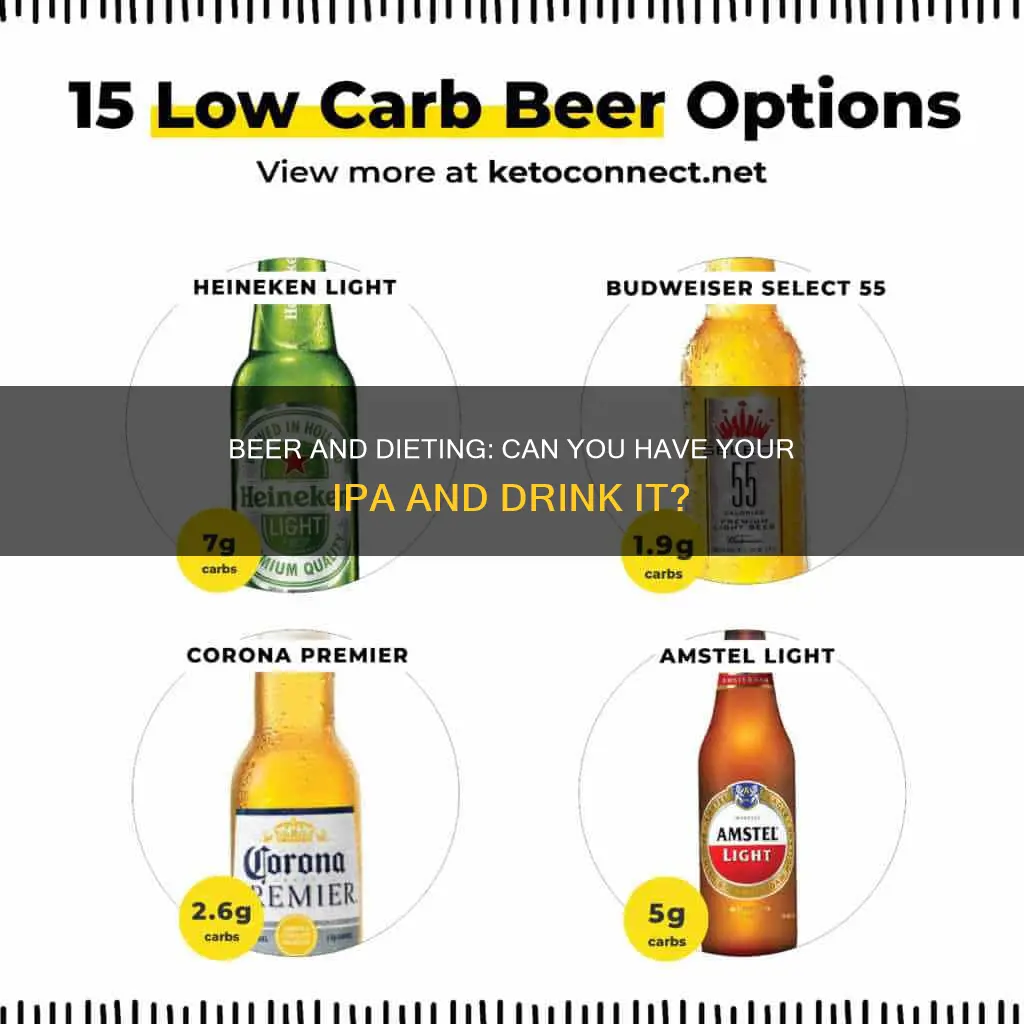
India Pale Ale, or IPA, is a popular beer known for its high hop content, which gives it a characteristic bitter taste. It often has a higher alcohol content than other beers. So, can you drink IPA beer while on a diet? The short answer is yes, but there are a few things to keep in mind. First, because of the high alcohol content, it's important to drink in moderation to avoid overdoing it. Second, the high hop content can have a diuretic effect, so staying hydrated by drinking plenty of water is crucial. Lastly, finding a brand that suits your taste preferences is essential, as not all IPAs are created equal. While it's possible to include IPA in a balanced diet, excessive consumption can lead to negative health effects, including weight gain and nutrient deficiencies.
| Characteristics | Values |
|---|---|
| Alcohol content | Higher than other beers |
| Calories | 170-240 per 12-ounce serving |
| Carbohydrates | 12.8 grams |
| Protein | 1.66 grams |
| Fat | 0 grams |
| Diuretic effect | Yes |
| Taste | Bitter |
What You'll Learn

IPA calories and carbs
India Pale Ales (IPAs) are the third most popular style of beer, accounting for about 25% of all domestic craft beer sales. They are known for their hop bitterness, which is higher than that of other beers such as lagers. This higher hop content also means that IPAs have more calories and carbohydrates than other beers.
A regular 12 oz. (340 ml) beer has 155 calories, 1.66 grams of protein, 0 grams of fat, and 12.8 grams of carbohydrates. IPA beers, on the other hand, can range from 170 to 240 calories per 12-ounce serving, with some brands containing almost double the calories of a regular beer. For example, Sierra Nevada Torpedo Extra IPA has 237 calories and 14.1 grams of carbohydrates in a 12-ounce serving. The higher calorie count in IPAs is due to the higher amount of hops or malt in the beer mixture.
In terms of carbohydrates, a regular beer has around 12.8 grams of carbs, while an IPA can have up to 25 grams. The presence of more hops or malt in IPAs contributes to the higher carbohydrate content. As a rule of thumb, the more bitter the IPA, the more calories and carbs it contains.
While IPAs contain more calories and carbs than regular beers, this doesn't necessarily mean they are bad for your health. In fact, moderate consumption of IPA beer can have some health benefits. For example, a study by German scientists found that the hops in IPA may help protect the liver from the damaging effects of alcohol. Additionally, hops and malts are rich in silicon, which can contribute to stronger bones and healthier skin.
However, it's important to remember that excessive consumption of any alcohol, including IPA, can lead to negative health effects. As with any dietary choice, moderation is key. The 2015-2020 Dietary Guidelines recommend that adults of legal drinking age limit their intake to up to one drink per day for women and up to two drinks per day for men.
Bottoms Up Beer Dispensers: How Do They Work?
You may want to see also

Alcohol content and dieting
Beer is one of the most popular alcoholic beverages worldwide, with India Pale Ale (IPA) being one of the most popular styles. Characterised by its high hop content, IPAs tend to have a higher alcohol content than other beers. While it is possible to include IPA in your diet, there are a few important considerations to keep in mind.
Firstly, due to its higher alcohol content, moderation is key when consuming IPA. Excessive consumption of any alcoholic beverage can lead to negative health consequences and impact your fitness goals. It is recommended that women have up to one drink per day, while men can have up to two drinks per day. One drink is typically equivalent to 12 fluid ounces of beer.
Secondly, the high hop content in IPA can have a diuretic effect, increasing the frequency of urination. Therefore, staying hydrated by drinking plenty of water between beers is important. Additionally, the bitter taste of IPA may not be to everyone's liking, so finding a brand that suits your taste preferences is crucial.
When it comes to calorie intake, a regular beer typically contains around 153 calories, while a light beer is recommended by the USDA to have only 103 calories. IPA, on the other hand, can range from 170 to 240 calories per 12-ounce serving, with some brands containing almost double the calories of a regular beer. Therefore, if you are watching your calorie intake, limiting yourself to one or two IPA beers is advisable.
It is worth noting that the effects of alcohol consumption on weight gain vary depending on the type of alcohol and the amount consumed. Additionally, the dietary choices we make while drinking alcohol can also impact our weight. According to a study published in Current Obesity Reports in March 2015, there is a tendency to make poorer dietary choices as alcohol consumption increases. Therefore, minimising alcohol intake is generally a smart choice when trying to lose weight.
While beer may not be the healthiest beverage choice, it can be enjoyed in moderation as part of a balanced diet and fitness routine. To maintain a healthy weight, it is important to develop a consistent exercise routine and make conscious food choices in addition to watching your alcohol consumption.
Mixing Robitussin and Beer: Is it Safe?
You may want to see also

The health benefits of beer
Beer is often viewed as a guilty pleasure, but when consumed in moderation, it can have several health benefits. Firstly, beer is a rich source of nutrients such as vitamins B, C, and E, phosphorus, folate, niacin, and fibre. It also contains silicon, which has been linked to improved bone density and a reduced risk of osteoporosis. Beer is also a good source of polyphenols and the flavonoid Xanthohumol, which have been shown to fight against various cancers.
Beer may also contribute to a reduced risk of diabetes. A study published in the journal of the European Association for the Study of Diabetes found that people who drank beer 3 to 4 times per week were less likely to develop diabetes than those who abstained. Additionally, men who drank between one and six beers per week had a 21% lower risk of diabetes. Beer has also been linked to improved heart health, with moderate consumption associated with higher levels of HDL ("good" cholesterol) and a reduced risk of cardiovascular disease.
The hops in beer have anti-inflammatory properties and may help protect the liver from the damaging effects of alcohol. Beer can also aid in digestion due to its soluble fibre content and prebiotics, which promote the growth of good bacteria in the gut. Finally, beer may boost brain power and reduce the risk of Alzheimer's and dementia. The silicon in beer helps protect the brain from harmful compounds, and the improvement in blood flow to the brain associated with beer consumption may also contribute to better cognitive function.
While beer has potential health benefits, it is important to consume it in moderation. Excessive beer consumption can lead to adverse health effects, including weight gain, nutrient deficiencies, liver problems, and an increased risk of certain cancers. As with all alcoholic beverages, it is essential to drink in moderation and ensure it does not replace a balanced diet with adequate nutritional intake.
Skydiving Soon? Pre-Flight Beer: Yay or Nay?
You may want to see also

Beer and weight gain
Beer is often associated with weight gain, particularly around the belly—the infamous "beer belly". However, drinking beer in moderation (one beer per day or less) is not linked with significant weight gain or a beer belly. On the other hand, drinking large amounts of beer or binge drinking regularly puts you at a high risk of belly fat gain and various health problems.
Beer is high in carbohydrates and alcohol but low in other nutrients. The calorie content of beer depends on its strength—the more alcohol it contains, the more calories it has. A 12-ounce serving of regular beer with 4% alcohol content has approximately 153 calories. In comparison, a light beer has about 103 calories.
- Avoid binge drinking. Excessive alcohol consumption can lead to a beer belly as the body prioritises breaking down alcohol over burning fat, leading to abdominal fat deposition.
- Avoid binge eating while drinking. Drinking can make you forget about the food you're consuming, especially when engaged in conversation or other distractions.
- Choose healthier snacks to go with your beer. Opt for vegetables, protein-rich foods, or popcorn instead of fatty and calorie-rich options like chicken wings and pizza.
- Include non-alcoholic or alcohol-free beers in your rotation. These options have minimal to no alcohol and fewer calories, helping to reduce your overall calorie intake.
- Practice mindful drinking. Go for quality over quantity and savour a single heavier beer instead of drinking multiple lighter beers.
In conclusion, while beer can contribute to weight gain, particularly when consumed in excess, it is possible to enjoy beer in moderation as part of a balanced lifestyle that includes a healthy diet and regular exercise.
A Day's Drinking: Beer Binge and Health
You may want to see also

How to drink beer and stay fit
Beer is one of the most popular alcoholic drinks worldwide, with India Pale Ale (IPA) being one of the most popular styles. While beer is often associated with weight gain, it is possible to enjoy a drink and stay fit. Here are some tips on how to drink beer, including IPAs, while maintaining a healthy lifestyle:
Choose the Right Beer
When it comes to staying fit, not all beers are created equal. Opt for light beers or low-calorie craft beers instead of regular beers. Light beers typically have lower alcohol content, which means fewer calories. According to the USDA, a light beer has around 103 calories compared to 153 calories in a regular beer.
IPAs, however, tend to have higher alcohol content and can range from 170 to 240 calories per 12-ounce serving. So, if you're watching your weight, limit yourself to one or two IPAs and be mindful of the brand you choose. Some IPAs have lower calorie counts, such as Founders All Day IPA, which has 150 calories.
Practice Moderation
Moderation is key when it comes to drinking beer and staying fit. Most doctors consider moderate consumption to be one to two beers per day for men and one drink per day for women. Sticking to these guidelines will help you maintain a healthy weight and avoid the negative health consequences of excessive drinking.
Stay Hydrated
Beer, especially IPAs, can have a diuretic effect, making you urinate more frequently. To counteract this, drink plenty of water in between beers to stay hydrated. This will also help you feel fuller and may reduce your overall beer intake.
Be Mindful of Calorie Intake
Beer contains "empty calories," which means they provide little to no nutritional value. These calories can add up quickly, leading to weight gain. Be mindful of your total calorie intake for the day and adjust your food choices accordingly if you plan on drinking beer.
Pair with the Right Food
Pairing beer with the right food can enhance your drinking experience without derailing your fitness goals. IPAs go well with salty and oily dishes, such as burgers or oily fish like salmon or mackerel. Thai food, especially green curry, also pairs well with the citrus and herbal notes of IPAs.
Stay Active
To compensate for the extra calories from beer, stay active and incorporate fitness into your daily routine. Swimming and elliptical gliding are effective ways to burn calories. Regular exercise will help you maintain your weight and offset the negative impact of excessive drinking on your health.
In conclusion, while beer, including IPAs, is often associated with weight gain, it is possible to enjoy a drink and stay fit. By choosing the right type of beer, practicing moderation, staying hydrated, watching your calorie intake, pairing with the right food, and staying active, you can achieve a balance between enjoying a beer and maintaining a healthy lifestyle.
Beer and Prostate Surgery: What You Can Drink Post-Op
You may want to see also







